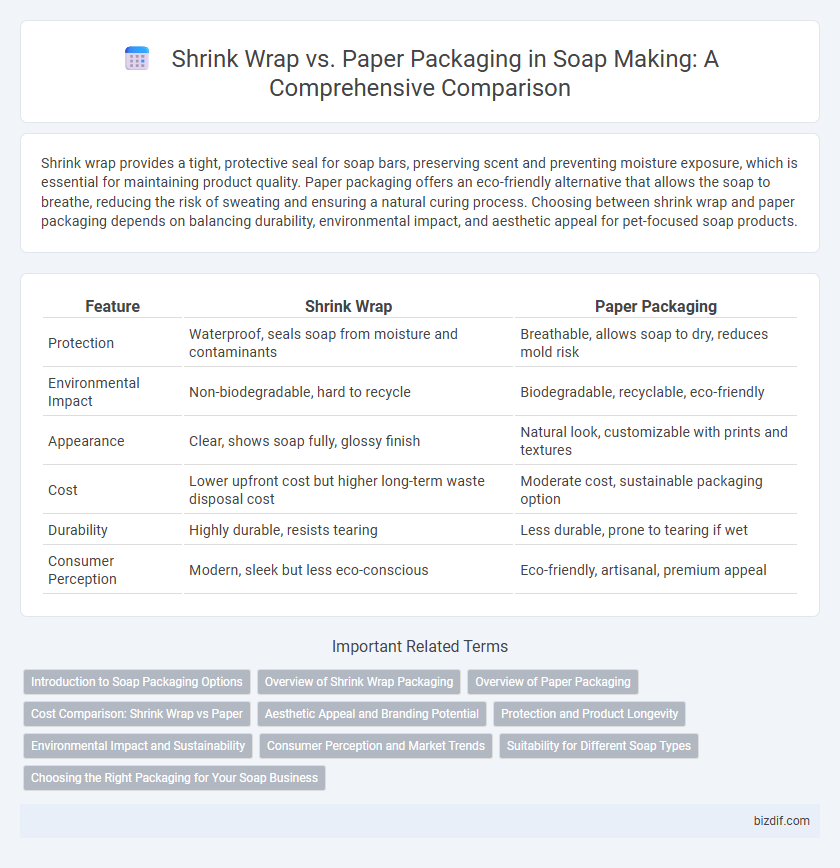Shrink wrap provides a tight, protective seal for soap bars, preserving scent and preventing moisture exposure, which is essential for maintaining product quality. Paper packaging offers an eco-friendly alternative that allows the soap to breathe, reducing the risk of sweating and ensuring a natural curing process. Choosing between shrink wrap and paper packaging depends on balancing durability, environmental impact, and aesthetic appeal for pet-focused soap products.
Table of Comparison
| Feature | Shrink Wrap | Paper Packaging |
|---|---|---|
| Protection | Waterproof, seals soap from moisture and contaminants | Breathable, allows soap to dry, reduces mold risk |
| Environmental Impact | Non-biodegradable, hard to recycle | Biodegradable, recyclable, eco-friendly |
| Appearance | Clear, shows soap fully, glossy finish | Natural look, customizable with prints and textures |
| Cost | Lower upfront cost but higher long-term waste disposal cost | Moderate cost, sustainable packaging option |
| Durability | Highly durable, resists tearing | Less durable, prone to tearing if wet |
| Consumer Perception | Modern, sleek but less eco-conscious | Eco-friendly, artisanal, premium appeal |
Introduction to Soap Packaging Options
Shrink wrap offers a transparent, tightly sealed protection that preserves soap freshness and prevents contamination during storage and transit. Paper packaging, often crafted from eco-friendly materials, provides breathability to maintain soap quality while appealing to environmentally conscious consumers. Choosing between shrink wrap and paper packaging depends on balancing durability, sustainability, and aesthetic appeal in soap presentation.
Overview of Shrink Wrap Packaging
Shrink wrap packaging provides a transparent, durable barrier that protects soap bars from moisture, dust, and contaminants while preserving their shape and scent. This packaging method uses heat to tightly seal the soap with a clear plastic film, enhancing product visibility and shelf appeal. Its airtight seal extends the soap's shelf life by preventing exposure to air and environmental elements.
Overview of Paper Packaging
Paper packaging for soap offers an eco-friendly alternative to plastic shrink wrap, incorporating biodegradable materials that reduce environmental impact. It allows for customizable designs, enhancing brand identity while providing adequate protection against moisture and contaminants. Sustainable paper options, such as recycled kraft or uncoated papers, support zero-waste initiatives and appeal to environmentally conscious consumers.
Cost Comparison: Shrink Wrap vs Paper
Shrink wrap packaging typically offers a lower upfront cost compared to paper packaging, making it a budget-friendly option for soap makers seeking economical solutions. However, paper packaging may result in higher material expenses but offers advantages such as eco-friendliness and better branding opportunities that can justify the investment. Factoring in waste disposal and sustainability goals can influence the overall cost-effectiveness between shrink wrap and paper packaging for soap products.
Aesthetic Appeal and Branding Potential
Shrink wrap enhances soap packaging by providing a clear, glossy finish that showcases the product's natural colors and textures, appealing directly to consumer sensory preferences. Paper packaging offers a more artisanal, eco-friendly aesthetic that aligns with sustainable branding efforts and attracts environmentally conscious buyers. Both options impact branding potential through their ability to convey product quality and values, with shrink wrap highlighting freshness and vibrancy, while paper emphasizes craftsmanship and environmental responsibility.
Protection and Product Longevity
Shrink wrap provides a tight, moisture-resistant seal that protects soap from environmental contaminants and extends its shelf life by preventing air and humidity exposure. Paper packaging, while eco-friendly and breathable, offers less protection against moisture and physical damage, potentially reducing soap longevity. For maximizing product lifespan and maintaining quality, shrink wrap is often preferred in soap packaging.
Environmental Impact and Sustainability
Shrink wrap packaging, typically made from single-use plastic, poses significant environmental challenges due to its non-biodegradable nature and contribution to landfill waste and ocean pollution. Paper packaging offers a more sustainable alternative, as it is biodegradable, compostable, and often sourced from renewable materials, reducing the overall carbon footprint in soap making. Choosing paper packaging supports eco-friendly practices by promoting recycling and minimizing plastic pollution, aligning with sustainable packaging initiatives in the soap industry.
Consumer Perception and Market Trends
Shrink wrap packaging offers a sleek, transparent presentation that highlights soap color and texture, appealing to consumers seeking modern and hygienic options. Paper packaging resonates with eco-conscious buyers by emphasizing sustainability and biodegradability, which aligns with the growing market trend favoring environmentally friendly products. Current market data shows increasing demand for biodegradable packaging, but shrink wrap remains popular for premium and artisanal soap lines due to its professional appearance and product protection.
Suitability for Different Soap Types
Shrink wrap provides a tight, moisture-resistant seal ideal for glycerin and specialty soaps that require protection from humidity and air exposure. Paper packaging is more suitable for cold process and handmade soaps as it allows the product to breathe, preserving the natural curing process and preventing sweating. Choosing between shrink wrap and paper packaging depends on the soap's moisture content and the need for breathability to maintain quality and appearance.
Choosing the Right Packaging for Your Soap Business
Shrink wrap offers airtight protection that preserves soap freshness and prevents moisture damage, making it ideal for high-humidity environments. Paper packaging provides eco-friendly, biodegradable options appealing to environmentally conscious consumers and allows for more customizable branding. Selecting between shrink wrap and paper packaging requires balancing product preservation needs with sustainability goals and target market preferences in the soap business.
Shrink Wrap vs Paper Packaging Infographic

 bizdif.com
bizdif.com